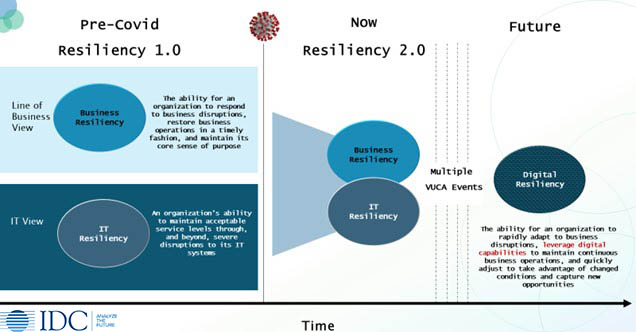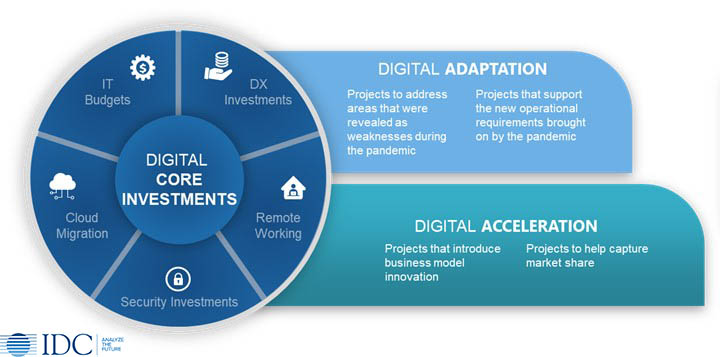Since the start of the global COVID-19 pandemic crisis earlier this year, we and our colleagues around the world continually noted how many of the classic assumptions about the ways that enterprises will address business disruptions and economic crisis failed to have any meaningful impact. Examples include:
- Business continuity plans based upon “lock downs” of critical personnel or the use of secondary (dark) sites quickly proved untenable as the crisis evolved.
- Companies instead scrambled to enable virtually all back-office workers, as well as many front line customer sales/support, to work from home.
- Supply-chain management, customer engagement processes, and decision support systems proved incapable of responding quickly to radical changes in demand streams.
- Enterprises replaced these bulky methods with solutions that built real-time collaboration across teams and rapid application development/deployment.
- IT resiliency plans based on classic data backup/replication and failover to secondary datacenters in unaffected areas proved impractical as IT teams struggled to gain physical access to either primary or secondary locations and faced major network performance bottlenecks.
- This struggle triggered a sharp increase in the use of colocation-based facilities with robust network interconnect options.
- Classic “capital control” and “asset life-cycle” extension strategies for IT systems/software, while still employed, could not provide the adaptability required to support newly remote workforces.
- Instead, organizations expanded their use of on-demand/ usage based options leveraging IaaS and SaaS, as well as flexible consumption of IT/network hardware to support remote workers.
All of these “new” approaches to planning/dealing with business and IT disruptions during the COVID-19 pandemic made it clear that an organization must be able to rapidly adapt and respond to this extreme business disruption to survive. What it also reveals is that even after the subsidence of the current crisis, the ability to rapidly respond and adapt to modest and extreme change is critical to future success in the next normal.
The Digital Economy Represents a Fundamental Acceleration in the Rate of Change
IDC believes that organizations succeeding in the digital economy need to excel at pivoting rapidly as any disruption happens. This is turning the attention of business and technology leader to the topic of resiliency. We are committed to helping organizations effectively shift their technology investments towards building resilience to survive in volatile, uncertain, complex and ambiguous (VUCA) environment.
However, historically there were two distinct perspectives on resilience in the context of any organization:
- Line of Business leaders focused more on Business Resilience, or ‘the ability for an organization to respond to business disruptions, restore business operations in a timely fashion, and maintain its core sense of purpose.’
- For technology leaders, it was all about IT resilience, which was all about an organization’s ability to maintain acceptable service levels through, and beyond, severe disruptions to its IT systems.
Let’s call that pre-pandemic resiliency ….In the wake of the pandemic, it became clear that these two definitions need to be brought a lot closer together to reflect that fact that every business process or value chain is underpinned by technology in a tightly integrated fashion, building any level of business resiliency is a major challenge (this is where we are now: post-pandemic resiliency).
However, the evolution of resiliency pre to post-COVID is only the first step. All organizations need to prepare for multiple VUCA events in the future. Organizations must transition to Digital Resiliency as outlined in the framework below:
Figure 1: The Journey to Digital Resiliency

The first step in that transition process is for the organization overall, and the IT organization that supports it, to adopt a new definition of resilience. One in which the business and IT worlds come together as one – in the form of digital resiliency. IDC defines the digitally resilient organization as one that rapidly adapts to business disruptions, and leverages digital capabilities to maintain continuous business operations, and quickly adjusts to take advantage of changed conditions and capture new opportunities.
IDC is also launching the Digital Resiliency Investment Index that makes it possible for enterprises to track the extent to which their technology investments as well as those of their business customers, competitors, and partners are shifting towards building this notion of digital resiliency.
The goal of the Index is to provide a composite view of digital resiliency among all organizations worldwide and the monitoring of investment shifts as a predictor of future tech investment rates and priorities. It is comprised of two factors – digital core investments and digital innovation investments. Together, they make up the Digital Resiliency Investment Index.
Figure 2: Elements of the IDC Digital Resiliency Investment Index:

The index also seeks to track how investments will vary over time based on changing conditions. These investments fall into three distinct categories:
- Core Investments: focus on maintaining business operations in the face of a VUCA market
- Adaptation Investments: moving quickly to take advantage of changing conditions
- Acceleration Investments: investing to build new capabilities to capture new market opportunities to drive growth
Investments in these areas aren’t simply “good ideas” for future plans. Major enterprises are already making investments across all these categories:
- Core Investments– Siemens recently deployed a connected workplace experience solution across 600 sites from the July through to October 2020 to create a safe return to work foundation for the future-proof digital workplaces. The solution combines location, usage and smart building data with a wide range of user demands to connect employees with their respective workplaces in line with local regulations and guidelines.
- Adapt – L’Oreal capitalized on investments in the e-commerce space over the past few years help to deliver $3,3billon in revenue and 65% growth in the first half of 2020 in the midst of the pandemic. However, it sees this as merely the starting point for expansion and scale. In fact, it believes that the e-commerce spike is not a bubble, it’s the new baseline. What has been interesting to see is how L’Oreal has now leveraged this expanded digital presence to create more digital connections, enhance its service portfolio and drive new levels of relevance with its customers. It has launched live streaming videos to deliver beauty coaching and ‘beauty-as-a-service’ as part of a new subscription model, while also doubling down on its investment in ModiFace – an augmented reality tech provider that it acquired in 2018. It has started to integrate these technology capabilities to replace physical testers with virtual equivalents as part of its broader digital expansion.
- Accelerate –BMW launched a bold initiative to redefine its operations with sustainability at the core. This cuts across supply chain, production and the product itself (i.e. the car) with specific carbon emission reduction targets, but also expected operational efficiency gains. This has not only involved an adaptation of its core operations to drive down costs, but also investing significantly in new technologies to respond to evolving customer expectations around sustainable operations and products. Oliver Zipse (the CEO of BMW) has made it clear that this is not an ad-hoc this initiative is part of BMW’s ambition to lead the manufacturing industry in sustainability.
As many parts of the global economy prepare for another wave of lockdowns, the need for resilience at individual, business and societal levels is becoming very clear. Digital technologies are very much potentially part of the solution.
At a personal level, our smartphones have kept us connected to our extended families and friends, digital channels have allowed us to get access to critical products and services and our streaming subscriptions have kept us entertained for the most part of 2020.
For businesses, the investments that organizations have made in technology, and specifically on digital transformation technologies, have allowed many businesses to maintain a level of operations that would never previously have been possible, and also to adapt and accelerate to capture new opportunities in the digital economy. This is the definition of digital resilience – a core element of IDC’s redefined version of the Future Enterprise.
Begin your journey to digital resiliency; see IDC’s October 2020 Digital Resiliency Investment Index now:
Rick Villars, Group Vice President, Worldwide Research, also contributed to this piece.




